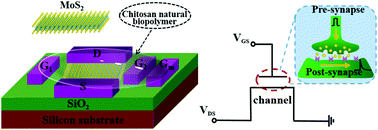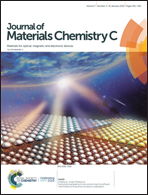Proton–electron-coupled MoS2 synaptic transistors with a natural renewable biopolymer neurotransmitter for brain-inspired neuromorphic learning†
Abstract
In neuroscience, information storage and retrieval of biological synapses in the brain are established by tuning the related ion fluxes. Inspired by such functionality, solid-state ionic/electronic hybrid devices are highly desirable for hardware implementation of brain-inspired neuromorphic computing systems. Here, nanoscale artificial synapses based on proton–electron-coupled van der Waals MoS2 transistors are presented using the natural chitosan biopolymer electrolyte as a neurotransmitter. Chitosan is one of the most abundant organic polymers on Earth and is non-toxic, renewable, as well as biocompatible. Using this kind of device, fundamental synaptic rules like excitatory postsynaptic current, paired-pulse-facilitation, and dynamic temporal filters are demonstrated. Moreover, the spatiotemporally correlated logic dynamics, tunable synaptic integration, and neuronal arithmetic operation are successfully mimicked. Further theoretical analysis using the first-principles calculation reveals that the proton–electron-coupled mechanism plays a critical role in the short-term synaptic potentiation. These results indicate that the artificial synapses we proposed here greatly enrich the intension of bionic electronics and represent a significant step toward future intelligent neuromorphic nanoelectronics.



 Please wait while we load your content...
Please wait while we load your content...